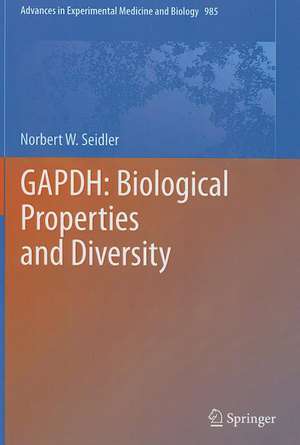GAPDH: Biological Properties and Diversity: Advances in Experimental Medicine and Biology, cartea 985
Autor Norbert W. Seidleren Limba Engleză Hardback – 31 iul 2012
| Toate formatele și edițiile | Preț | Express |
|---|---|---|
| Paperback (1) | 1103.29 lei 38-44 zile | |
| SPRINGER NETHERLANDS – 23 aug 2016 | 1103.29 lei 38-44 zile | |
| Hardback (1) | 1430.35 lei 6-8 săpt. | |
| SPRINGER NETHERLANDS – 31 iul 2012 | 1430.35 lei 6-8 săpt. |
Din seria Advances in Experimental Medicine and Biology
- 9%
 Preț: 719.60 lei
Preț: 719.60 lei - 20%
 Preț: 691.93 lei
Preț: 691.93 lei - 5%
 Preț: 717.00 lei
Preț: 717.00 lei - 5%
 Preț: 716.28 lei
Preț: 716.28 lei - 5%
 Preț: 717.20 lei
Preț: 717.20 lei - 15%
 Preț: 640.24 lei
Preț: 640.24 lei - 5%
 Preț: 1113.83 lei
Preț: 1113.83 lei - 5%
 Preț: 715.71 lei
Preț: 715.71 lei - 5%
 Preț: 820.43 lei
Preț: 820.43 lei - 15%
 Preț: 641.38 lei
Preț: 641.38 lei - 5%
 Preț: 716.28 lei
Preț: 716.28 lei - 5%
 Preț: 523.99 lei
Preț: 523.99 lei - 5%
 Preț: 1031.00 lei
Preț: 1031.00 lei - 5%
 Preț: 717.00 lei
Preț: 717.00 lei - 5%
 Preț: 715.35 lei
Preț: 715.35 lei - 20%
 Preț: 1161.71 lei
Preț: 1161.71 lei - 5%
 Preț: 1170.51 lei
Preț: 1170.51 lei - 18%
 Preț: 1119.87 lei
Preț: 1119.87 lei - 5%
 Preț: 1288.48 lei
Preț: 1288.48 lei - 5%
 Preț: 1164.67 lei
Preț: 1164.67 lei - 5%
 Preț: 1101.73 lei
Preț: 1101.73 lei - 18%
 Preț: 1123.67 lei
Preț: 1123.67 lei - 5%
 Preț: 1435.64 lei
Preț: 1435.64 lei - 20%
 Preț: 1044.10 lei
Preț: 1044.10 lei - 18%
 Preț: 946.39 lei
Preț: 946.39 lei - 5%
 Preț: 292.57 lei
Preț: 292.57 lei - 18%
 Preț: 957.62 lei
Preț: 957.62 lei - 18%
 Preț: 1235.76 lei
Preț: 1235.76 lei - 5%
 Preț: 1231.55 lei
Preț: 1231.55 lei - 5%
 Preț: 1292.30 lei
Preț: 1292.30 lei - 5%
 Preț: 1102.10 lei
Preț: 1102.10 lei - 18%
 Preț: 1132.81 lei
Preț: 1132.81 lei - 5%
 Preț: 1165.19 lei
Preț: 1165.19 lei - 5%
 Preț: 1418.48 lei
Preț: 1418.48 lei - 5%
 Preț: 1305.63 lei
Preț: 1305.63 lei - 18%
 Preț: 1417.72 lei
Preț: 1417.72 lei - 18%
 Preț: 1412.99 lei
Preț: 1412.99 lei - 24%
 Preț: 806.16 lei
Preț: 806.16 lei - 18%
 Preț: 1243.29 lei
Preț: 1243.29 lei - 5%
 Preț: 1429.44 lei
Preț: 1429.44 lei - 5%
 Preț: 1618.70 lei
Preț: 1618.70 lei - 5%
 Preț: 1305.12 lei
Preț: 1305.12 lei - 18%
 Preț: 1124.92 lei
Preț: 1124.92 lei - 5%
 Preț: 1097.54 lei
Preț: 1097.54 lei - 15%
 Preț: 649.87 lei
Preț: 649.87 lei - 5%
 Preț: 1097.54 lei
Preț: 1097.54 lei - 18%
 Preț: 945.79 lei
Preț: 945.79 lei - 5%
 Preț: 1123.16 lei
Preț: 1123.16 lei
Preț: 1430.35 lei
Preț vechi: 1505.64 lei
-5% Nou
Puncte Express: 2146
Preț estimativ în valută:
273.73€ • 297.23$ • 229.93£
273.73€ • 297.23$ • 229.93£
Carte tipărită la comandă
Livrare economică 22 aprilie-06 mai
Preluare comenzi: 021 569.72.76
Specificații
ISBN-13: 9789400747159
ISBN-10: 9400747152
Pagini: 312
Ilustrații: XIV, 295 p.
Dimensiuni: 178 x 254 x 22 mm
Greutate: 0.93 kg
Ediția:2013
Editura: SPRINGER NETHERLANDS
Colecția Springer
Seria Advances in Experimental Medicine and Biology
Locul publicării:Dordrecht, Netherlands
ISBN-10: 9400747152
Pagini: 312
Ilustrații: XIV, 295 p.
Dimensiuni: 178 x 254 x 22 mm
Greutate: 0.93 kg
Ediția:2013
Editura: SPRINGER NETHERLANDS
Colecția Springer
Seria Advances in Experimental Medicine and Biology
Locul publicării:Dordrecht, Netherlands
Public țintă
ResearchCuprins
1. Basic Biology of GAPDH. - 2. GAPDH and Intermediary Metabolism. - 3. Compartmentation of GAPDH. - 4. Functional Diversity. - 5. GAPDH, as a Virulence Factor. - 6. Target for Diverse Chemical Modifications. - 7. Dynamic Oligomeric Properties. - 8. Multiple Binding Partners. - 9. GAPDH in Anesthesia.
Recenzii
From the book reviews:
“The biochemical, physiological, and metabolic roles of GAPDH is discussed starting with the cell membrane and ionic mechanisms of glycolysis, energetics, and the TCA cycle. This is a book which should explore in greater detail the effects on blood brain barrier and CNS metabolism. I do however, highly recommend this book to physiologists and biochemists. Graduate students and postdocs will probably find this a very good discussion of GAPDH.” (Joseph J. Grenier, Amazon.com, August, 2014)
“The biochemical, physiological, and metabolic roles of GAPDH is discussed starting with the cell membrane and ionic mechanisms of glycolysis, energetics, and the TCA cycle. This is a book which should explore in greater detail the effects on blood brain barrier and CNS metabolism. I do however, highly recommend this book to physiologists and biochemists. Graduate students and postdocs will probably find this a very good discussion of GAPDH.” (Joseph J. Grenier, Amazon.com, August, 2014)
Textul de pe ultima copertă
GAPDH (glyceraldehyde 3-phosphate dehydrogenase) is more than just a glycolytic enzyme. An unprecedented amount of literature demonstrates that GAPDH has an astounding multiplicity of function. This diversity is not simply due to cell compartmentation (i.e. redistributing glycolytic energy to where it is needed), although this feature is undoubtedly important and discussed in the book. GAPDH integrates glycolysis with other cellular processes. This concept of integration cannot be understated. But, there is more.
GAPDH actively participates in numerous non-glycolytic cellular events that fall into very broad categories including the cell infrastructure and the transmission of genetic information. Some of GAPDH’s biological properties are completely non-intuitive given the current undergraduate textbook understanding of this glycolytic enzyme. For example, GAPDH binds to select phospholipids and catalyzes organelle biogenesis. It has fusogenic properties, enabling it to be actively involved in nuclear envelop reassembly, autophagy and membrane trafficking. Human macrophages exhibit surface-localized GAPDH with receptor function. As scientists, we are trained to consider GAPDH as a soluble cytosolic dehydrogenase enzyme. The literature observations - as described in this book - tell us something quite different. Besides oxidoreductase activity, GAPDH exhibits peroxidase, uracil DNA glycosylase, nitrosylase, mono-ADP-ribosylase, esterase and phosphotransferase activity. GAPDH binds membrane transport proteins, G-proteins, poly-nucleotides, adenines, specific lipids, select carbohydrates, cytoskeletal proteins, nuclear import and export proteins, diverse ATPases, molecular chaperones and other molecules.
GAPDH actively participates in numerous non-glycolytic cellular events that fall into very broad categories including the cell infrastructure and the transmission of genetic information. Some of GAPDH’s biological properties are completely non-intuitive given the current undergraduate textbook understanding of this glycolytic enzyme. For example, GAPDH binds to select phospholipids and catalyzes organelle biogenesis. It has fusogenic properties, enabling it to be actively involved in nuclear envelop reassembly, autophagy and membrane trafficking. Human macrophages exhibit surface-localized GAPDH with receptor function. As scientists, we are trained to consider GAPDH as a soluble cytosolic dehydrogenase enzyme. The literature observations - as described in this book - tell us something quite different. Besides oxidoreductase activity, GAPDH exhibits peroxidase, uracil DNA glycosylase, nitrosylase, mono-ADP-ribosylase, esterase and phosphotransferase activity. GAPDH binds membrane transport proteins, G-proteins, poly-nucleotides, adenines, specific lipids, select carbohydrates, cytoskeletal proteins, nuclear import and export proteins, diverse ATPases, molecular chaperones and other molecules.
Caracteristici
Provides a resource of ideas and references for biomedical researchers that are preparing grant applications Contains a comprehensive synthesis of GAPDH information from widely-divergent fields Provides a thorough introduction for scientists developing antibiotics, anti-cancer agents, and anti-apoptotic agents










